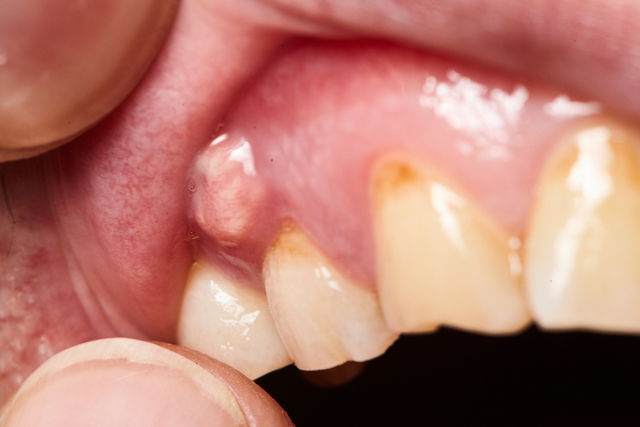A gum blister normally emerges due to some type of inflammation or infection on the gums or tooth. It is common with gingivitis, periodontitis or untreated, deep cavities. They can also appear due to mucoceles or canker sores.
Generally, gum blisters do not cause any symptoms, however it can lead to bleeding gums, swelling, fever, difficulty opening the mouth, pain and bad breath.
It is important to consult a dentist to identify the cause of the gum blister and to start treatment as necessary. The dentist may advise better dental habits, or antibiotics in some cases.

What causes gum blisters?
The main causes of gum blisters include:
1. Mucocele
A mucocele is a benign mucus cyst that occurs due to obstruction of the salivary glands or mouth trauma, leading to the formation of a saliva-filled blister. It frequently occurs on the lips, but can also affect the gums, roof of the mouth, tongue or cheeks. Learn more about the symptoms of a mucocele and what can cause them.
Mucoceles are not significant and generally do not cause pain, unless they are associated with another wound.
What to do: This lump normally disappears within a few days and does not require treatment. However, if it becomes very large or does not resolve within 2 weeks, you should see a dentist for possible surgical removal of the salivary gland to reduce swelling.
2. Infection
An infection in the mouth, like an abscess or fistula, can lead to blisters on the gums. It is normally a natural defense mechanism the body employs to eliminate an infection.
This infection is normally the result of food that has accumulated within the teeth and of lack of dental hygiene. These factors can lead to bacteria in the mouth to grow and spread, leading to the formation of cavities and bacterial plaques (also known as tartar).
What to do: The best way to prevent gum blisters from infections and food build-up is to correctly brush your teeth. The teeth and tongue should be brushed at least three times a day, followed by a thorough flossing. To remove the rest of the food that can linger in the teeth, you should use a mouth wash.
3. Canker sores
Canker sores appear in any part of the body, including the gums, which can lead to pain and discomfort when talking and chewing. They can appear due to a weakened immune system, use of dental equipment and acidic foods. Learn more about what causes cancer sores and how to treat them.
What to do: To relieve pain and discomfort from cancer sores, you can gargle warm water and salt to help speed-up healing and reduce the risk for infection. If the canker sores do not resolve within a few weeks, or if you notice other symptoms, you should see a dentist for further assessment, as the canker sores can be a sign of other health conditions, like Crohn's disease or Sjögren syndrome.
4. Dental fistula
A dental fistula forms as a result of the body's attempt to eliminate an infection. They lead to the formation of pus-filled blisters in the mouth or on the gums. These should not be ruptured at home.
What to do: You should see a dentist for assessment and treatment to prevent infections. The dentist may recommend an oral gargle to eliminate the underlying cause of the fistula, and antibiotics may be prescribed It is important to cleanse the mouth correctly, using dental floss and mouth wash.
5. Gingivitis and periodontitis
Gingivitis is an inflammation of the gums caused by bacterial plaque or tartar along the gums. It occurs due to poor dental hygiene and is associated with symptoms like red gums, bleeding when brushing and persistent bad breath.
Gingivitis that is left untreated can affect the tissue that surrounds the teeth, like the periodontal ligament or alveolar bone, leading to damage and bone loss, as well a periodontal abscesses (pus-filled blisters).
What to do: You should consult a dentist for assessment and diagnosis of gingivitis or periodontitis. the dentist can remove the accumulated tartar, although it is important to continue brushing the teeth with a soft brush or electric brush, and to use dental floss on a daily basis. Periodontitis may need treatment with antibiotics or even surgery.
6. Untreated or deep cavities
Untreated or deep cavities can affect the pulp of the tooth and lead to the formation of an apical abscess. This is a pus-filled blister at the root of the tooth, which can form into a fistula that exits the deepest part of the gums.
What to do: Treatment for cavities should be oriented by a dentist through the root's canal. The doctor may prescribe antibiotics prior to treatment. In some cases, a full tooth extraction may be necessary.
7. Pemphigus vulgaris
Pemphigus vulgaris is a rare autoimmune disease that is characterized by the production of antibodies that attack and destroy cells of the buccal mucosa. It leads to the formation of blisters and wounds along the gums, cheeks roof of the mouth, tongue or throat. These can be painful, burning, and leave dark spots that persist for months after they disappear.
Generally, blisters start in the mouth or throat, and are often confused for canker sores. They can then emerge on the skin and in other moist areas, like the nose, eyes, genital organs, anus and esophagus. These blisters can rupture and become ulcerated.
What to do: Pemhigus vulgaris is a serious disease that requires treatment. If you notice any signs of this illness, you should see a family doctor or dermatologist to start treamtent, which usually involves corticosteroids, immunosuppressants or antibiotics.
